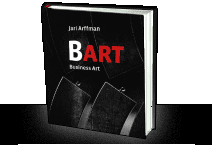In 2002, Petri Tamminen writes about a factory chimney in his book
Piiloutujan maa (the land of the hiding):
“There are lots of sounds in the high brick chimney. The wind plays a tune, roaring, howling and growling. On calm days, it is totally silent. Then you have to cough, stamp your feet or clap your hands together. The echo is gloomy. But not menacing, it is like a friend in a high place who promises lasting safety.”
This could serve as a good description of a Bart product by a Bart artist. Bart products are made to celebrate a company’s lasting image. The chimneys are disappearing, but they are still fine symbols of company independence. Within a company there lives a dream of security, a security that is built out of work. The staff are still the most important thing for the company. Even in these days of the quartal economy, there is an ideal of the captain of industry who offers continuing security to those who do their work well. This safe place is documented in Bart artists’ photographs. Photography as an art has achieved the same status as film and painting. Bart photographs preserve the history of a company, even though the company changes over the decades.
The German August Sander began photographing portraits of workers in the 1930's, using the methods of art photography. His photographs showed workers sweating in their working clothes, while actually at work. These images represented a change from previous pictures of workers: now the worker was treated with respect: Sander’s picture was as unique and as professional as the photograph of the director of the factory. Bart artists are carrying on August Sander’s tradition. All who make a contribution to profits are shown equally strongly in their art photographs.
The other main artistic approach in Bart, alongside the pictures of workers, is the Bart artist’s interpretations of the company’s products. These could be called product portraits. They have little in common with traditional product photographs. Every image or detail seeks out the most personal form and mood of the object or machine. The images include sharp-honed gearwheels, as well as the swarf left over by machine tools. As an artist the photographer endows each object with its own personality.
Bart is a photographic artist’s celebration of work. The company uses art to demonstrate respect for its own work. Bart is a simple concept, like all successful, practical solutions: the artist makes an agreement with the company to photograph the factory, the staff, and the results of their work. The difference from other company photographs is the artistic ‘Bart viewpoint’ created by the Bart artist. The result can also be an art gift for the company’s partners in collaboration.
Bart photographs do what they appear to do: nothing is staged or taken out. Sometimes the workers do not even know that the photographer is coming. Bart artists talk about the human contact that their work gives them, and about the creative freedom of a rapid shooting session. They particularly enjoy the energy of the workplace and the simplicity of working with workers. Sometimes the photographer has to run after the worker to get the best picture. The different personalities give each company a different spirit and culture. It is rewarding for a photographer to meet a company and its people, since their goal is to make ambitious art.
Bart artists take spectators to places where they are not usually allowed to go. A modern factory and its storerooms are much cleaner spaces than were the old workshops filled with greased machinery, in the days when everything was made by hand. Both factories and modern architecture have shared a goal of cleanliness for over a century now. These days, factory architecture even incorporates features from church architecture. Factories have become temples of technology. In them human beings direct and finish off the work done by a machine. Robots have now joined in, sharing the work with the workers. This change in the very concept of work is visible in Bart artists’ photographs.
A factory is a distinct visual environment. In the harsh light of the factory the visible elements, beams and storage units, worktables and machinery, are seen as sharply outlined forms, with lots of deep darkness between them. This blackness plays an important role in Bart photographs. Deep black brings the secret of darkness into the images. It leaves room for thoughts from the past and for options about the future. In their photographs Bart Artists tell mythic tales of everyday environments and the history of work in Europe.
Asko Mäkelä
Art Historian









